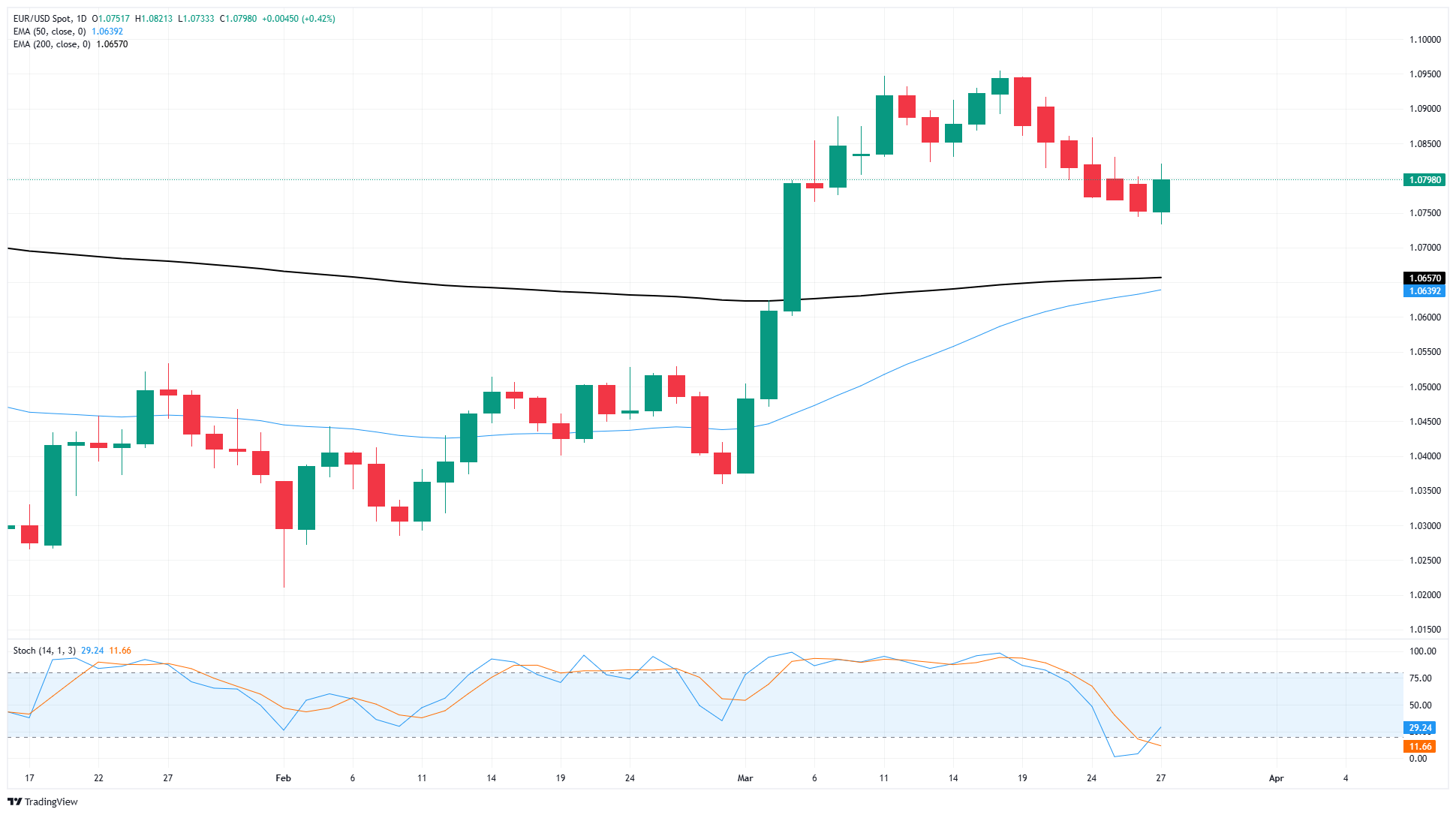EUR/USD Streaking Streak attracts, but Sunday clouds continue to collect

- EUR/USD increased by 0.4% on Thursday and caught a six -day loss line.
- The fiber approached the 200 -day EMA in a dangerous way, pointing to a potential reversal.
- US inflation data stands out just before the introduction of tariffs.
EUR/USD took a breath on Thursday, one tenth of one percent rose and caught the six -day loss line, which saw that the fiber fell to a 2% summit. Tariff concerns continued to move away from the center of investors’ attention times, but on Thursday, US President Donald Trump had a brief relief after accelerating a new series of tariff declarations through social media.
For the fourth quarter 2024, GDP increased by 2.4%and exceeded their expectations by 2.3%. However, Moody’s warned that higher tariffs and tax cuts can significantly increase government deficits and potentially reduce US debt ratings and lead to higher treasury returns.
S&P Global is warned that US policy uncertainty can prevent global growth, while Fitch ratings can seriously affect smaller economies such as Brazil, India and Vietnam, and may complicate US goods capabilities. The CBO reduced the 2025 GDP forecast to 1.9%, predicted that the growth rate would continue until 2035, and inflation slowed down until 2025. In addition, the budget deficit increases to 7.3% of GDP without policy adjustments, and 5.4% of interest payments can meet 5.4% of the GDP by 2055.
The basic US data version of this week will be the basic personal consumption expenditure price index (PCE) that must be paid on Friday. Investors hope that an recent rise in inflation figures will be temporary, but median forecasts expect annual PCE inflation to rise to 2.7% in February.
EUR/USD Price Estimation
When Fiber’s recent losing line is broken, EUR/USD bid owners will want to push prices over the current target in the 1,0900 branch. Fiber has lost its basis at the basic technical level, but buyers have at least managed to stop bleeding for now.
The price action is still shaking for the 200 -day exponential moving average (EMA) near the 1,0700 -day. If technical support breaks and sales pressure begins to dominate, the last swing near 1,0350 is a long decline.
EUR/USD Daily Graphics
EURO FAQ
The Euro is the currency of the 19 European Union countries belonging to the Euro region. It is the second most traded currency in the world behind the US dollar. In 2022, it made up 31% of all foreign exchange transactions with an average turnover over an average of $ 2.2 trillion per day. EUR/USD is the most severe currency that follows EUR/JPY (4%), EUR/GBP (3%) and EUR/AUD (2%).
Frankfurt is a reserve bank for the euro region of the European Central Bank in Germany (ECB). ECB determines interest rates and manages monetary policy. The primary task of the ECB is to maintain price stability, which means to control inflation or promote growth. The primary instrument is to raise or reduce interest rates. Relatively high interest rates – or higher rates – the expectation of the ratios – usually will benefit the euro and vice versa. The ECB Management Council takes monetary policy decisions at meetings held eight times a year. Decisions are made by six permanent members, including the heads of the Euro Region National Banks and the President of the ECB Christine Lagarde.
Euro region inflation data measured by the compatible index of consumer prices (HICP) is an important economy for euro. If inflation rises more than expected, especially if the ECB is over 2% target, it forces to increase interest rates to control the ECB. The relatively high interest rates compared to their counterparts will usually benefit the Euro, because the region makes the region more attractive as a place for global investors to park their money.
Data versions measures the health of the economy and may affect the euro. All indicators such as GDP, manufacturing and services PMIs, employment and consumer emotion surveys may affect the direction of a single currency. A strong economy for euro is good. Not only does it attract more foreign investments, it can also encourage ECB to put interest rates, which directly strengthens the euro. Otherwise, if the economic data is weak, the euro is likely to fall. Economic data for the four largest economies in the Euro region (Germany, France, Italy and Spain) are particularly important because they constitute 75% of the economy of the Euro region.
Another important data version for the Euro is the trade balance. This indicator measures the difference between what a country earns from its exports and what it spends for imports in a certain period. If a country produces a high rate sought after exports, the currency gains value from the extra demand created by foreign buyers who want to buy these goods. Therefore, a positive net trade balance strengthens a currency and is the opposite for a negative balance.




